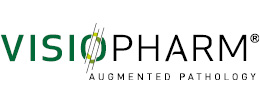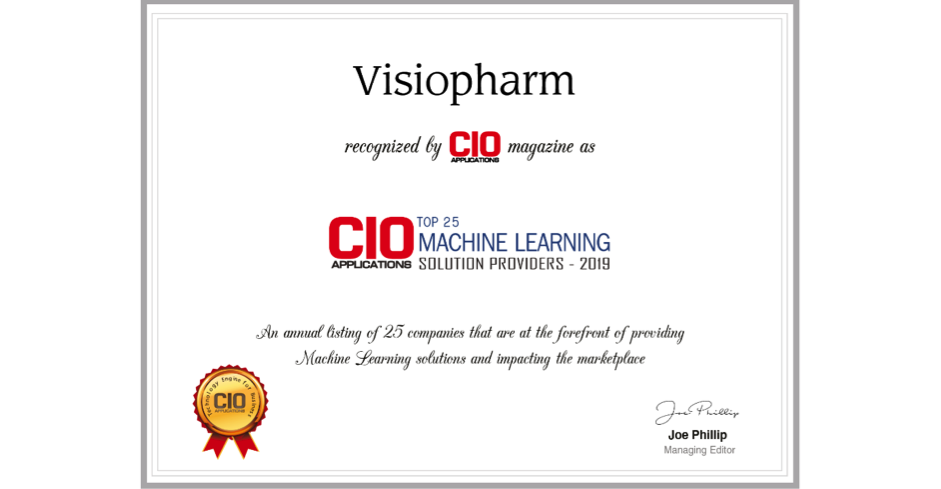CIO Applications awards Visiopharm as one of the top 25 machine learning solutions providers

CIO Applications recently sat down with our founder and CEO Michael Grunkin. The technology print magazine focuses on usage of various tech start ups. In the latest issue the spotlight was placed on the marketplace of machine learning providers and the difficulties in zeroing in on the best. To address this, CIO Applications took up the challenge and located the “Top 25 Machine Learning Solution Providers – 2019”.
Here is the full interview from CIO Applications where CEO Michael Grunkin, shared his insights into how AI and machine learning-enabled image analysis software has demonstrated the potential to make a real difference in tissue-based research and diagnostics.
Augmenting Pathologists—Image Analysis with AI
Clinicians rely heavily on tissue samples that are interpreted by pathologists under a microscope. This practice has been in place for hundreds of years and is now ready to be automated, as leading quantitative digital pathology solution provider, Visiopharm, applies AI and Machine Learning in their image analysis software. Digitized pathology images, known as Whole Slide Images (WSI), represent several challenges to obtain meaningful, reproducible, and standardized analysis.
Interesting advances in technology usually always happens at the intersection between different fields of science and technology. Diagnostic quantitative digital pathology is no exception: it lies firmly at the intersection between computer science, image analysis, and applied mathematics. I was a technical founder of two earlier diagnostic companies based on image analysis. This was a valuable learning experience that showed the enormous potential diagnostic image analysis has toward providing both data quality and automation. It later became clear that there is a huge unmet need in the field of pathology.
Pathology relies heavily on manual reading and interpretation of biological tissue structures. With subjective and error-prone manual processes, diagnostic digital pathology has an enormous potential to automate and improve tissue-based diagnostics. This is becoming increasingly important in an era of new targeted cancer therapies. These treatments have the potential to significantly improve the prognosis for cancer patients. The driving vision behind Visiopharm, which my co-founder Johan Dore and I founded back in 2001, is to support pathologists and scientists with the tools to identify the right treatment, for the right patient, at the right time.
What are some trends that you see emerging in pathology, and how is Visiopharm leveraging those?
The advent of WSI has enabled the market for quantitative digital pathology both in diagnostics and research. WSI allows you to digitize an entire microscope slide at very high resolution and view it from a monitor. Digital Pathology helps scientists and pathologists to replace the traditional microscope, and assess important cellular and morphometric structures more efficiently directly on screen.
The ability to digitize slides is just the first step in the journey toward automated precision pathology. The manual assessment of complex biological tissue structures and biomarker response often represents a formidable cognitive challenge, especially with a whole new generation of biomarkers that are used to characterize the tumor micro-environment. Over the years, we have been able to understand, identify, and quantify the error sources from biopsy to data. We have taken a radical approach to simplify and improve the entire process for pathologists. We use machine learning and AI technology to mitigate or eliminate these error sources and achieve higher interpretive accuracy of tissue data.

Visiopharm’s main focus is cancer research and diagnostics. As we speak, there are more than 600 new immunotherapies in late stage development.
This new generation of cancer treatments presents new challenges for pathology. Immunotherapies are expensive targeted therapies, meaning that only a sub- population of patients will respond to the treatment.
This is where Visiopharm makes a difference. Our image analysis workflows and algorithms improve the interpretive accuracy of some of the most challenging and time-consuming manual pathology reads.
Our technology can provide decision support for pathologists and scientists that are tasked with making important diagnostic, research or business decisions based on tissue data.
How has Visiopharm’s Oncotopix® and AI been able to imprint its exclusivity in the pathology market?
The simplicity in workflow, combined with the flexibility and power of the software, enables our customers to easily configure new diagnostic or research APPs without the need for programming skills. In particular, our commitment to data quality, has made us one of the most widely-adopted solutions in the market.
Without consistent good stain quality, it is often not possible to make an accurate diagnosis. Visiopharm has been able to use our image analysis platform to find new and effective ways to measure the variability in stain quality. We are working closely with EQA organizations to provide Qualitopix™, our platform that will effect change and significantly impact the standardization of tissue diagnostics.
Lastly, we have invested significantly in integrating to existing digital infrastructure, including Image Management, Lab Information, and PACS systems. Our solutions now plug directly into existing workflows and augment the pathologist with APPs for precision pathology.
Could you cite a case study describing how you enable clients to overcome hurdles and obtain desired outcomes with your innovative digital pathology solutions?
We recently supported Karolinska Institute in Stockholm on a research project to understand the magnitude of manual reading errors throughout the diagnostic process. The researchers used Ki-67, a biomarker for distinguishing between two sub-types of breast cancers, where the treatment selection depends on the classification of the patient into one of these two sub-types. The study demonstrated a 30 percent manual misclassification rate between these cancer types. Visiopharm’s software significantly reduced this error.
We also recently finished installation of our Oncotopix® Dx for breast cancer in hospitals throughout Denmark.
Some of the most notable results, was considerable time and money savings on reflex molecular testing for inconclusive breast cancer cases. For a large fraction of patients, we could completely eliminate the need for the molecular test. This saves money for laboratories, but more importantly, it greatly reduced the waiting time for these patients.
What does the future hold for your organization?
Visiopharm continues to demonstrate double-digit year over year growth. This validates both the magnitude of the unmet need in the market, and our ability to address that need effectively. We are selling our solutions to diagnostic pathology labs, biopharmaceutical companies, academic medical centers, and contract research companies that all have similar needs. We see a clear window of opportunity to continue this growth, expand geographically and lead market innovation. With the recent strong financial support from Danish investors, our next phase of growth involves launching our diagnostic technology into the U.S., a market that is already strong for Visiopharm in drug development and research.
Source: Visiopharm
































